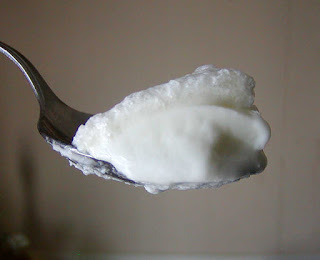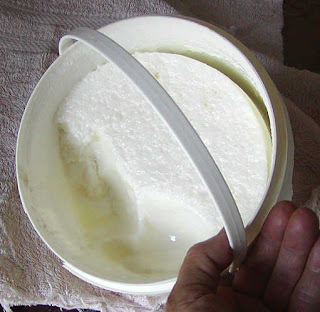
We love yogurt and it's so versatile! You can eat it plain, with fruit on it, put it on cereal and cook with it. It makes all kinds of great desserts and it is so good for you!
We use so much of it that we make our own in a 2 litre bucket. It makes quick and easy, much faster than buttermilk, but not easier. It doesn't make at room temperature like buttermilk does, however, so it has to be heated up and put into a container that will hold the heat long enough (about 8 hours). We ordered our 2 litre bucket yogurt maker from a cheese company in New England many years ago. It's just like the ones that used to be in every home in the 70's and 80's. It is a simple styrofoam cooler, not electric, that the plastic bucket fits in, so it can be made anywhere. I know people who have pur their yogurt containers in other small styrofoam coolers that hold in the heat and covered it wth a warm quilt or blanket. This seems to work and would do in a pinch, if you didn't have an actual "yogurt maker".
It doesn't make at room temperature like buttermilk does, however, so it has to be heated up and put into a container that will hold the heat long enough (about 8 hours). We ordered our 2 litre bucket yogurt maker from a cheese company in New England many years ago. It's just like the ones that used to be in every home in the 70's and 80's. It is a simple styrofoam cooler, not electric, that the plastic bucket fits in, so it can be made anywhere. I know people who have pur their yogurt containers in other small styrofoam coolers that hold in the heat and covered it wth a warm quilt or blanket. This seems to work and would do in a pinch, if you didn't have an actual "yogurt maker".
We let our yogurt "make" about 8 hours. If you like it less tart, you can take it off earlier.
The thickness of the finished yogurt depends on the milk solids in it. If you want a really solid yogurt, add powdered milk to the milk before putting it in the maker. We used to do this regularly until powdered milk got so expensive. To the 2 litre bucket we make, we added about 1/2 cup of powdered milk. Now that I don't use it, our yogurt is a bit thinner and wetter, but it's still great yogurt. What we make now is similar to many brands of store bought yogurt.
I have discovered that the addition of plain gelatine will help keep it from watering, so now I add about 2 teaspoons of gelatine to the 2 litres of milk when it is very hot and use the hand blender to dissolve it. If you are adding powdered milk to it, the hand blender would be useful too. If you wanted to get creative and you like fruit yogurt, I suppose you could use flavored gelatine, but I have never done so. You can also add sugar, sweetener, jam or fruit to it at this stage. Freezer jam makes great yogurt. It's the sugar and almost fresh fruit all in one.
I use yogurt to start it. I rarely ever buy actual "yogurt starter". Any yogurt will do, as it has the live bacteria culture (acidophilus) in it. I usually make yogurt when there is a little left in the bucket. It doesn't take much (1/2 cup to 2 litres). I spoon it out of the bucket and set it aside, then wash the bucket before making new yogurt in it. I also buy a small plain yogurt when I need to, in order to start a new batch.
Here is a list of what you need to make yogurt: milk to fill your container(s), powdered milk (if using it), gelatine (if using it), thermometer, yogurt starter, and a container/arrangement that will hold the yogurt and hold the heat in for 8 hours.
To make the yogurt, gently heat the milk to 190 degrees F, stirring more or less continuously. Turn off heat. Add the gelatine and powdered milk and blend until dissolved. Cool the milk to 112 degrees F, then add the yogurt starter. If you add the starter to the milk when the milk is still too hot, you will kill the bacteria and it won't make yogurt. If you let it get too cool, it won't make yogurt either. Anywhere around 110-112 degrees going in, with everything added, will make good yogurt. If you don't heat the milk to 190 degrees, you might get yogurt and you might not. It's risky. You might get another bacteria in there that will make something other than yogurt.
Being exact with cleanliness and temperatures is something one gets used to if one makes wine or soap regularly. Making yogurt is much easier ! Try it! Yogurt is so good for you!
 Good, solid yogurt without a lot of water.
Good, solid yogurt without a lot of water.
 I love rugosa roses! In addition to being beautiful, they are also prolific and I use a lot of rose petals and hips in the kitchen!
I love rugosa roses! In addition to being beautiful, they are also prolific and I use a lot of rose petals and hips in the kitchen!
 Any rose can be used for cooking. They are all edible, but the rugosa roses are so easy to grow. You can grow rows of them just from cuttings or seed and they will reseed themselves if left alone. I prefer to grow things from seed, rather than cuttings if possible, because of the genetic diversity but if I am in a hurry for more, I will use cuttings. When you plant a handfull of rose seeds, you could get any kind of rose from those seeds, throwbacks from ancesters of that rose or a genetic rarity. You just never know what you are going to get. Not all roses grow well from seed but rugosa roses do and they produce a lot of tasty hips too!
Any rose can be used for cooking. They are all edible, but the rugosa roses are so easy to grow. You can grow rows of them just from cuttings or seed and they will reseed themselves if left alone. I prefer to grow things from seed, rather than cuttings if possible, because of the genetic diversity but if I am in a hurry for more, I will use cuttings. When you plant a handfull of rose seeds, you could get any kind of rose from those seeds, throwbacks from ancesters of that rose or a genetic rarity. You just never know what you are going to get. Not all roses grow well from seed but rugosa roses do and they produce a lot of tasty hips too!

Rose hips are very high in vitamin C (approximately 1,700 mg of C in 100 gm of dried rosehip). That's higher than oranges and grapefruits! Rose hips have become a popular natural treatment for arthritis due to their anti inflammatory and anitoxident effects. Rose hips also contain carotenoids, including beta-carotene, lycopene, beta-chryptoxanthin, rubixanthin, zeaxanthin and lutein.
If you just thought roses were for the flowerbed, you were wrong! Plant them in your herb garden!
 I plan to plant rows and rows of them this year from seed and cuttings. I already have a beautiful violet one (pictured above) and pink ones. Who knows what I will get from open pollinated seed! I love surprise gardening! They are stratified, being collected this week from the roses outdoors, so should be ready to germinate. It does take awhile to grow a rose bush, but they are worth the wait and if you plant a lot of seed, you get a lot of rose buses!
I plan to plant rows and rows of them this year from seed and cuttings. I already have a beautiful violet one (pictured above) and pink ones. Who knows what I will get from open pollinated seed! I love surprise gardening! They are stratified, being collected this week from the roses outdoors, so should be ready to germinate. It does take awhile to grow a rose bush, but they are worth the wait and if you plant a lot of seed, you get a lot of rose buses!
 I made wine from the rose petals last year. It has been ready for a few weeks now and is my favourite so far! The rose bouquet fills my nose when I drink it. It's like summer in a bottle!
I made wine from the rose petals last year. It has been ready for a few weeks now and is my favourite so far! The rose bouquet fills my nose when I drink it. It's like summer in a bottle!
Add rose petals to salads and sandwiches!
Below are some simple rose recipes:
Basic Rose Hip Tea: Pour 1 cup of boiling water over 2 heaping teaspoons of chopped rose hips. You can use rose hips with or without their seeds. Steep the herbal tea, covered, for 15 minutes and strain.
Pose Petal Jelly
2 cups flower petals (or fresh young herb leaves)
2 1/4 cups water
1/4 cup lemon juice
600 oz liquid pectin (2 pckges) or equivalent powder (You may find that the liquid works better for this purpose than the powder)
4 cups sugar
Rose Hip Jam Take two cups Rose hips. Wash thoroughly and cut out the black calyx. Cook hips in two cups water until tender. Mash fruit while cooking. Push pulp through a fine sieve and to each cup of pulp add one cup of water. Then cook until the pulp thickens to the consistency of other jams.
Rose Honey
1 and 3/4 cups cleaned rose hips
2 and 1/2 cups water
Cook rose hips in the water about 15 minutes and occasionally crush them. When they are tender, pour into jelly bag and strain off juice. This quantity yields about 7/8 cup of juice to which add enough water to make a cupful then add one tsp. lemon juice, 3/4 cup sugar and cook rapidly until juice jellies on a silver spoon. This will thin to a honey consistency when cold. It is delicious served on waffles, pancakes, over desserts or in cakes and frostings.
Candied Rose Petals
Rose petals must be dry and clean. Dip both sides in slightly whipped egg whites, then coat both sides of the petals immediately with granulated sugar and lay carefully on waxed paper. Allow to dry thoroughly before packing in boxes. To speed drying, turn the petals once. Keep dry and cool.
Rose Petal Syrup (See previous pose on dandelion syrup)
4 cups rose petals
2 cups water
2 cups sugar
Boil rose petals in water for an hour. Remove petals with a sieve and add sugar. Boil until thick and syrupy.
Rose Petal Butter
1 Cup fresh Rose Petals, chopped
3/4 Cup softened unsalted Butter
Mix together well and let stand at room temperature for at least 2 hours. Cover and refrigerate for 24 hours to let the rose flavor meld into the butter. Keep refrigerated up to 2 weeks or frozen for several months.
Rose Petal Pesto
Two Cups Fresh Basil
One Cup Rose Petals
4 Large Garlic Cloves
1 Cup of Olive Oil
1 Teaspoon Rosewater
1 Cup of Freshly Grated Parmesan Cheese
1/4 Cup of Freshly Grated Romano Cheese
Salt and Freshly Ground Pepper to taste
Rinse Rose Petals and Basil thoroughly and pat dry. Cup up Rose Petals with sharp scissors. Peel and chop garlic. Combine the basil, garlic and Pine nuts, chop in either a food processor or blender. While still processing add olive oil and rose water slowly. Add the Parmesan and Romano, salt and pepper, blend lightly.
Green Tea and Rose Petal Popsicles
3 cups water
1-1/2 tbsp green tea leaves (about 3 tea bags)
1/4 cup assorted organic small rose petals.
Bring the water to a boil and remove from heat. Pour over tea in a ceramic teapot. Fill popsicle molds loosely with rose petals. Steep tea for 5 minutes and strain into popsicle holders. Freeze in the freezer for 30 minutes, then place the wooden sticks in the center of the popsicle holders. (This is a good time to spread the petals throughout the mold evenly.) Freeze until solid and serve immediately.
Rose Petal Ice Cream Makes approx. 3 cups.
1 cup heavy cream
1 cup whole milk
1 cup sugar
5 large egg yolks
1 ½ cups loosely packed, very fragrant old rose petals, washed and dry.
Follow directions for your individual ice cresm freezer.
I have open pollinated rugosa rose seeds for sale in my seed store now. They are stratified, being collected this week from the roses outdoors, so should be ready to germinate.

 It doesn't make at room temperature like buttermilk does, however, so it has to be heated up and put into a container that will hold the heat long enough (about 8 hours). We ordered our 2 litre bucket yogurt maker from a cheese company in New England many years ago. It's just like the ones that used to be in every home in the 70's and 80's. It is a simple styrofoam cooler, not electric, that the plastic bucket fits in, so it can be made anywhere. I know people who have pur their yogurt containers in other small styrofoam coolers that hold in the heat and covered it wth a warm quilt or blanket. This seems to work and would do in a pinch, if you didn't have an actual "yogurt maker".
It doesn't make at room temperature like buttermilk does, however, so it has to be heated up and put into a container that will hold the heat long enough (about 8 hours). We ordered our 2 litre bucket yogurt maker from a cheese company in New England many years ago. It's just like the ones that used to be in every home in the 70's and 80's. It is a simple styrofoam cooler, not electric, that the plastic bucket fits in, so it can be made anywhere. I know people who have pur their yogurt containers in other small styrofoam coolers that hold in the heat and covered it wth a warm quilt or blanket. This seems to work and would do in a pinch, if you didn't have an actual "yogurt maker".

 Good, solid yogurt without a lot of water.
Good, solid yogurt without a lot of water.









